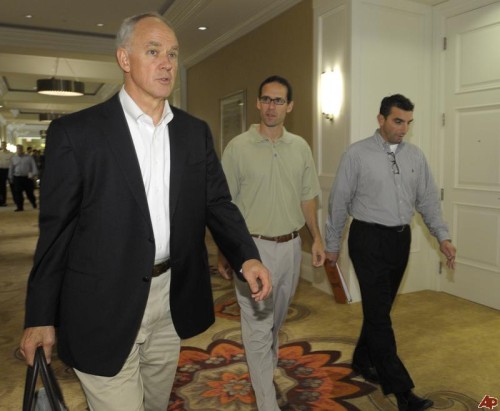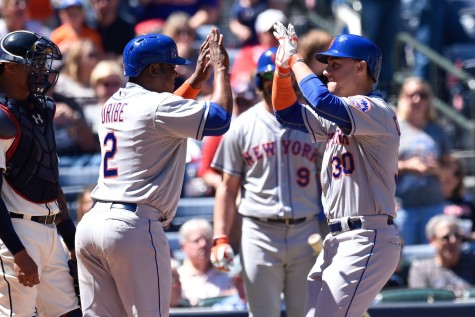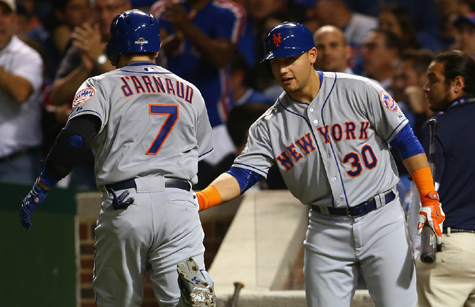
When Sandy Alderson was installed as the new general manager of the Mets in October of 2010, he inherited a team whose public persona had been battered and stigmatized by the effects of the Madoff scandal as well as a plunge in the standings. The campaign just concluded had resulted in the second of what would be four consecutive 4th place finishes in the division, an ugly comedown for a squad that had contended strongly during the heyday of the Willie Randolph-led era from 2006 through 2008.
As an essentially hand-picked-by-the-Commissioner successor to the splashy and largely successful tenure of Omar Minaya (“specially Selig-ted” if you will), Alderson was viewed by much of the fanbase and NY press as a kind of “conservator” whose mission was to oversee a hobbled operation that faced an indeterminate period of forced financial restraint. Charged with a rebuild, although that term would rarely be invoked, he assembled a front office staff whose “moneyball” pedigree purportedly could allow at least a faint hope of contention in the near term.
The reality of the situation would prove far less optimistic, and with the institution of a “small-cap value” vs. “large-cap growth” philosophy in the area of player acquisition (something that will make the most sense to those familiar with investment terminology), a new age of organizational identity was underway. The deadline trade of Carlos Beltran to the Giants for Zack Wheeler in July of 2011 put any remaining illusions of an immediate turnaround to rest.
Despite all signs pointing to the contrary, Sandy, never the most forthcoming of people during a press conference, steadfastly maintained that his personnel decisions were not primarily made for financial reasons and that the front office had one eye on keeping the current team viable for some realistic level of contention. While some degree of truth, stretched though it may be, was undoubtedly present in these statements, the overall direction of the organization was made manifest by the character of the team’s transaction log.
One-year contracts for reclamation projects became the order of the day, and if a reasonable level of performance was the reward, the player in question, now armed with negotiating leverage born of a bounce-back season, was allowed to seek greener pastures elsewhere (e.g. Chris Capuano).
 Meanwhile, the Mets intelligentsia headed back to the bargain bin to pad the roster for the next go-round. The decision not to trade eventual free agent shortstop Jose Reyes for prospects was viewed askance after he signed a big money contract with the Marlins in December of 2011, but the team was able to draft promising backstop Kevin Plawecki with the compensation pick they received as a result. Otherwise, the scrapheap remained the primary shopping destination for patches to the lineup, rotation, or bullpen of the big club while a strategy was being put in place for farther down the line.
Meanwhile, the Mets intelligentsia headed back to the bargain bin to pad the roster for the next go-round. The decision not to trade eventual free agent shortstop Jose Reyes for prospects was viewed askance after he signed a big money contract with the Marlins in December of 2011, but the team was able to draft promising backstop Kevin Plawecki with the compensation pick they received as a result. Otherwise, the scrapheap remained the primary shopping destination for patches to the lineup, rotation, or bullpen of the big club while a strategy was being put in place for farther down the line.
Consequently, mound innings were soaked up by the likes of 40-ish Miguel Bastista (kind of a less-sexy “Big Sexy”) and Chris Young (the 6’ 10” soft tosser who came back to haunt the team in the 2015 WS), while at-bats went to the likes of lefty-killer Scott Hairston and utility man Willie Harris.
When R.A. Dickey (one of Minaya’s remaining reclamation projects) unexpectedly morphed into the greatest one-season knuckleball phenomenon in baseball history, Alderson had the good sense to sell high and parlay the 2012 Cy Young winner into what increasingly appears to be a largely one-sided trade with the Toronto Blue Jays. Two components of that deal, catcher Travis D’Arnaud and Nordic-by-way-of-Texas quasi-deity Noah Syndergaard, figured significantly in this past season’s near-championship run and look to provide the possibility of the same going forward while lower level “throw-in” Wuilmer Becerra’s performance in A-Ball has tantalized fans by demonstrating his toolsy future possibilities.
The following season, a similar scenario resulting from the signing of veteran (and PED-tarnished) outfielder Marlon Byrd who was spun off to the Pirates for promising infielder Dilson Herrera and since-departed reliever Vic Black. Along the way, Minaya-regime signees such as Matt Harvey, Jacob deGrom, and Steven Matz have been nurtured along and now stand to comprise the balance of an historically fearsome (even by Mets’ standards) starting rotation.
The increasingly impressive statistics compiled by the team’s young starters and newly appointed closer Jeurys Familia highlighted why the team’s surprising early-2015 performance was more than a fluke. At the same time, the abysmal numbers put up by the offensive side of the equation signaled a warning that the team’s policy of prospect hoarding was no longer the correct strategy to follow.

The evolution of the team and its front office was made clear during the latter part of last July when, in the space of a week, the lineup was transformed by a series of transactions that added Kelly Johnson and Juan Uribe from the Braves, the heralded prospect Michael Conforto from AA Binghamton, and most significantly, Yoenis Cespedes from the Detroit Tigers. As we all know, this set of moves worked about as well as one could hope and the suddenly league-leading offense that resulted nearly brought a championship to the Queens faithful, a possibility that seems oh-so realistic going forward now that Cespedes’ services have been retained for the upcoming season and perhaps beyond.
Is it just me, or did it seem as if things began happening at a seriously accelerated pace last summer once the decision was made to go for it? How much more restraint would have been used in maintaining the integrity of the Met minor league system has the big club lagged somewhat farther behind the Nationals heading into the season’s second half? Would the fluctuating concept of Matt Harvey’s innings limit have been of greater concern? Would Conforto and his sweet swing been ticketed for a bump up to Vegas instead of Flushing? What kind of dam had to break to actually lend some credence to the idea that Sandy could spend if he felt it was warranted? Was the team able to do it all along, at least at the “middle market” level?
Regardless, through a combination of calculated gambles, intuitive moves with prospects, and decisive action once decisions were made, it appears that whatever oddball path of a five-year plan was used by Sandy Alderson and his sabermetric brain trust to get the Mets where they are has worked, at least for the most part.
Granted, there have been some duds (e.g John Mayberry, Brad Emaus) and talent miscalculations along the way (e.g Justin Turner), but nobody’s perfect. The Cespedes signing, at what are clearly terms that favor the team over the player, may best represent the triumph of the Alderson approach. He will wait, and wait, and wait, sometimes to the point of driving the team’s fans to the point of madness, but in the end he often gets what he wants, the way he wants it. And right now, his methodology resembles nothing so much as true vision.
















